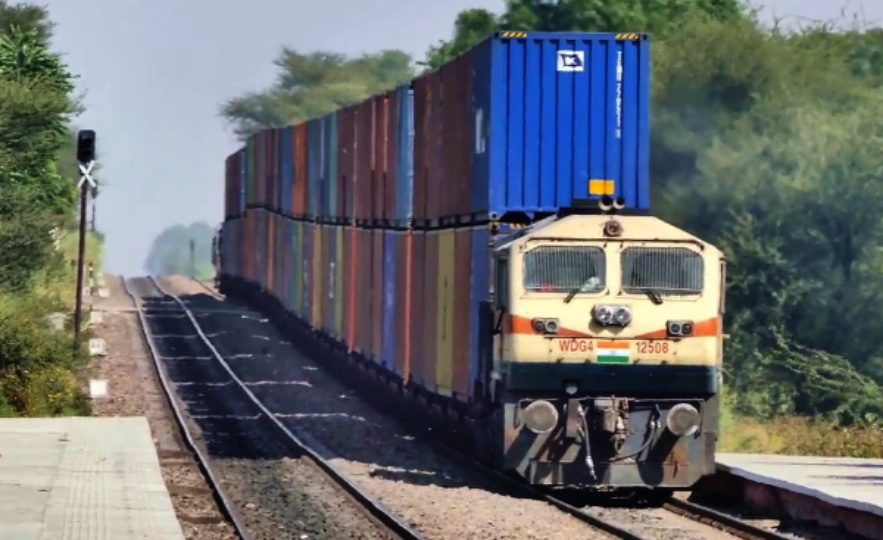
Decarbonizing freight transport in India
NEW DELHI : With massive investment in capacity augmentation, Indian Railways (IR) has been trying very hard to attract non-bulk traffic for more than a decade now, but with limited success. It is also a matter of concern that railway’s share in price-inelastic bulk-commodities, which have been the traditional sources of freight revenue is also declining. A recent study conducted by TERI found that the present freight tariff policy is divorced from market realities and is an important factor behind such a decline. Also, issues such as excessive detentions (in-route and at terminals), stabling, inefficient terminal operations, lack of availability of wagons, etc., work against when a shipper considers railways as a choice for shipment.
With more than 90 percent of the track length being electrified, IR has been a forerunner in the world in terms of shifting away from diesel-based traction. On the contrary, the road freight sector in India is overwhelmingly dominated by diesel vehicles with negligible presence of electric vehicles. India’s Nationally Determined Contribution (NDC) submission to the United Nations in 2015 highlighted the government’s resolve to increase the share of railways in land transport to 45 percent.
Railways once handled the lion’s share of freight movement in India, accounting for about 65 percent in early eighties. Over the years with several push and pull factors, road transport has replaced railways as the dominant mode of transport, accounting for almost 70 percent of the cargo handled by 2022. One of the primary reasons was change in railway’s policy that discouraged piece-meal traffic that is, the carriage of smaller volume traffic. The non-bulk traffic which could not offer a ‘train load’ that is carriage of large volume traffic that could be carried in a full train, gradually shifted to road.
The continued decline of railway’s share in freight transport sets the course of India’s ‘transport decarbonization’ ambition to a wrong trajectory. At present heavy-duty segment of road freight transport appears to be ‘the’ hard-to-abate sector, hence, increasing rail-share is a sine qua non to decarbonize freight transport. But what greenhouse gas (GHG) emission abatement potential does railways hold?
TERI recently undertook a study to assess the impacts of different mitigation strategies on the GHG emissions from Indian transport sector (road, rail, aviation) till 2070–71. These strategies encompass electrification of vehicles, introduction of hydrogen fuelled vehicles, fuel efficiency improvements, use of biofuels, and shift of freight traffic from road to railways in line with the NDC vision of 45 percent by 2030-31 and a stable 50 percent share of rail in freight by 2040-41 onwards. Among these strategies increasing the share of railways in overall freight transportation has a significantly high abatement impact.
With aggressive electrification of road transport and accelerated uptake of hydrogen as fuel (starting early 2040s), it was found that GHG emission would reduce 3 percent by 2030 and 31 percent by 2050. However, when these levers are coupled with increasing share of railways in freight transport, GHG emission abatement potential gets accentuated. Such a mixed strategy will result in a 30 percent reduction by 2030 and 58 percent by 2050. So, an aggressive policy of shift of freight traffic from road to rail unlocks additional emission abatement to the extent of 27 percentage points.
Reaching a 45 percent freight share in total national freight is not at all an ambitious target as IR has ably demonstrated a consistent growth of over seven per cent during first decade of the millennium. Such an increase will have much wider impact on environment and India’s net-zero by 2070 commitment. As serious handicap of capacity deficit on railways has already been resolved with capacity augmentation projects including near completion of dedicated fright corridors, it is now necessary that railways adopt proactive policies to attract freight traffic from road. These measures include flexibility in freight pricing, exploring alternative pricing mechanisms, simplification of freight-rate structure, improvements in terminal operations, ensuring timely availability of wagons, mechanised speedy goods handling at terminals, commodity-specific marketing polices, etc.
It is also important to incentivising the shippers to shift to railways for shipment by incorporating transport sector into the under-development Indian Carbon Market by integrating with the Carbon Credit Trading Scheme of the Bureau of Energy Efficiency. The tradability of emission savings owing to modal-shift can play a vital role in generating additional demand for railways.
